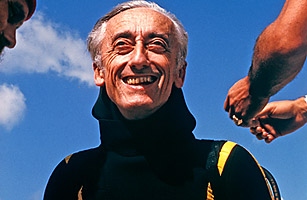
"I hate danger," the Frenchman Jacques-Yves Cousteau once said. How to credit such a remark from a man who plunged below the ocean's surface more than 30,000 times, free-diving to depths of 300 feet? Fifty fathoms down: an unlikely spot to find a man who suffered chronic anemia as a child and remained thin and wiry for 87 years. But as much as he might have hated danger, he loved the sea — particularly the undersea. "From birth," Cousteau wrote, "man carries the weight of gravity on his shoulders ... But man has only to sink beneath the surface and he is free. Buoyed by water, he can fly in any direction — up, down, sideways — by merely flipping his hand. Underwater, man becomes an archangel."
Above water, Cousteau was a sainted figure to the millions who watched his wondrous films and television shows, and, particularly, to other divers. Man had wanted to dive forever: The ancient Assyrians imagined breathing underwater, depicting people sucking air from goatskin bellows. In the 19th and early 20th century, divers breathed oxygen pumped from above; it was a perilous business, as tubes could snap, severing the lifeline. By the 1930s, compressed air was brought below, but an inefficient hand-operated valve system, among other shortcomings, meant short and shallow dives.
Enter Cousteau, a French naval officer and avid diver. He wasn't satisfied with the status quo and began to experiment. In the late 1930s, Cousteau designed a breathing apparatus that filtered carbon dioxide from exhaled oxygen, then delivered purified air back to the tank. Testing his invention nearly killed him when, during a dive, the recirculated oxygen turned toxic as he passed 45 feet. "My lips began to tremble uncontrollably," Cousteau recalled later. "My eyelids fluttered. My spine was bent backward like a bow. With a violent gesture I tore off the belt weight and lost consciousness." Cousteau floated to the surface, where he was hauled aboard by his boat crew and revived. He suffered pain for weeks.
In 1943, Cousteau and engineer Émile Gagnan built a different device, which they called the Aqua-Lung. This was a demand-valve system that automatically fed divers compressed air with each breath. It also matched air pressure with that of the surrounding water so that a diver's lungs wouldn't be damaged. Cousteau tested the instrument off the coast of France, performing underwater somersaults, handstands and barrel rolls more than 30 feet down. The air flowed smoothly, and, said Cousteau, "From this day forward we would swim across miles of country no man had known, free and level, with our flesh feeling what the fish scales know."
Cousteau continued almost mystically: "To swim fishlike, horizontally, was the logical method in a medium eight hundred times denser than air. To halt and hang attached to nothing, no lines or air pipe to the surface, was a dream. At night I often had visions of flying by extending my arms as wings. Now I flew without wings."
He was, obviously, many things: adventurer, inventor, filmmaker and something of a poet. In more than 150 documentaries and through dozens of books, he communicated his abiding love of science as well as his sense of wonder. Armed with his Aqua-Lung, he continued to flirt with danger — despite himself. He tested the impact of underwater explosions for the French Navy, and he swam among the sharks. In his trademark red cap and high-tech research vessel, Calypso, Cousteau led 55 expeditions, in locales from Alaska to Antarctica. He went in search of Atlantis in the Aegean. When he died in 1997, the whole world mourned. We had lost the pied piper of the seven seas.